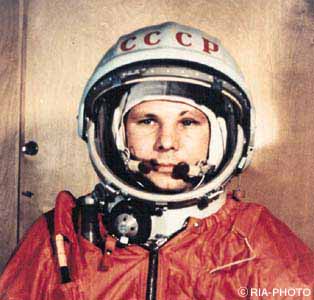YURI GAGARIN

Major Yuri A. Gagarin, age 27, was the
first man to orbit Earth. He was a Soviet cosmonaut. He was also
a Soviet Air Force pilot and a parachutist.
Yuri Gagarin's parents were peasants on
a collective farm in the village of Gzhatsk. Gagarin thus represented
the ideal of the "new communist man." Gzhatsk is now
called "Gagarin City."
Sergei Korolev was the Soviet Union's chief rocket designer. He
selected Gagarin to be the first cosmonaut to orbit the Earth.
Gherman Titov was chosen as the backup.

Gagarin's spacecraft was called Vostok
1. He said that Vostok 1 was "more beautiful than a locomotive,
a steamer, a plane, a palace, and a bridge -- more beautiful than
all of these creations put together."
The booster rocket for the spacecraft was
called A-1. The booster had three stages.
The launch site was the Baikonur Cosmodrome,
which is located near the city of Tyuratam in Kazakhstan, close
to the Aral Sea.
Gagarin made a single orbit of the Earth
on April 12, 1961. His flight lasted 1 hour and 48 minutes. The
apogee was about 203 miles above sea level. The orbital speed
was approximately 17,000 miles per hour.
During the flight, Gagarin monitored onboard
systems, ate, drank, and watched the Sun rise over North America.
Sergei Korolev asked over the radio, "How do you feel?"
Gagarin replied, "I feel fine. How about you?"
After the flight, Gagarin reported, "I could clearly discern
the outlines of continents, islands and rivers. The horizon presents
a sight of unusual beauty. A delicate blue halo surrounds the
Earth, merging with the blackness of space in which the stars
are bright and clear cut."
During reentry, the Vostok capsule was supposed to separate cleanly
from its equipment module, but the two remained tethered by an
umbilical line. The Vostok spacecraft tumbled at a rate of 30
degrees per second. As a result, Gagarin experienced an acceleration
of 10 G. The tumbling continued until the umbilical cord finally
burned through.
As part of the flight plan, Gagarin exited
the spacecraft at an altitude of about 20,000 feet and then parachuted
to the ground. He landed near Saratov in the Volgograd region.
The Soviet government apparently kept this
parachute detail secret for many years. The Soviets sought to
give an impression that the Vostok spacecraft made a soft landing
with Gagarin still inside. The Federation Aeronautique International
required that a pilot land with his vehicle in order to claim
a complete flight for the record books.
Soviet Premier Nikita Khrushchev congratulated
Gagarin after the flight, declaring: "You have made yourself
immortal because you are the first man to penetrate space."
Gagarin replied: "Now let the other
countries try to catch us."
After the flight, Gagarin visited 28 countries. He attended banquets,
gave speeches, and answered fan mail.
Gagarin also supervised training for women cosmonauts, which led
to Valentina Tereshkova's flight in June 1963.
The people of the Soviet Union called Gagarin, the "Columbus
of the Cosmos."
Gagarin died in an airplane crash on March
27, 1968. He was on a training flight in a MiG-15 aircraft.
ALAN SHEPARD
Alan B. Shepard was the first American
in space. He made a short, suborbital flight on May 5, 1961.
JOHN GLENN
John Glenn was the first American to orbit
Earth. His flight was on February 20, 1962.
REFERENCE
Tom Harpole, "Saint Yuri," Smithsonian
Air & Space Magazine, Smithsonian Institution, Washington
D.C., Dec 98/Jan 99.
ORDER FROM AMAZON

The
Rocket Men : Vostok and Voskhod, the... _______________________________________________________________________________________________
Please send comments and questions to Tom
Irvine at: tomirvine@aol.com


